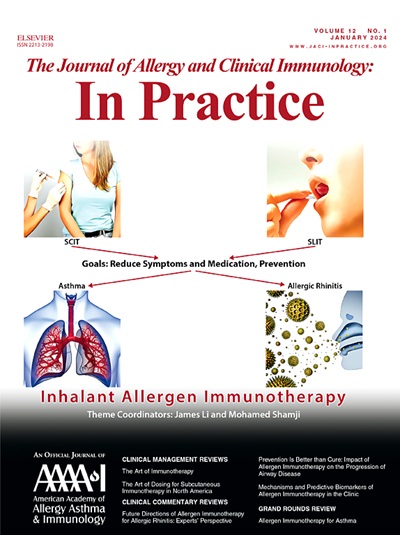Real-World Effectiveness of Biologic Therapy in Allergic Bronchopulmonary Aspergillosis
IF 8.2
1区 医学
Q1 ALLERGY
Journal of Allergy and Clinical Immunology-In Practice
Pub Date : 2025-05-01
DOI:10.1016/j.jaip.2025.03.006
引用次数: 0
Abstract
Background
Allergic bronchopulmonary aspergillosis (ABPA) is characterized by a severe hypersensitivity reaction to Aspergillus species. Current treatment relies on oral corticosteroids (OCS) and triazole antifungal therapy, but there is increasing evidence of the benefits of biologic therapies targeting type 2 inflammatory pathways.
Objective
To assess the real-world effectiveness of biologic therapies in patients with ABPA.
Methods
We performed a large retrospective single-center analysis of patients with ABPA as defined by the modified International Society for Human and Animal Mycology (ISHAM) criteria between 2014 and 2022. Baseline characteristics were recorded. Clinical outcomes were assessed at 12 months after commencement of a biologic including symptom scores, exacerbation frequency, corticosteroid use, and multidisciplinary team consensus of effectiveness.
Results
A total of 74 patients received a biologic, of whom 32% (n = 24) received anti-IgE therapy, 65% (n = 48) anti-IL5/5Rα therapy, and 3% (n = 2) anti-IL4-Rα therapy. Of the total, 65% (n = 48) patients were deemed to have a successful response at 12 months with a ≥50% reduction in OCS use and 35% (n = 26) stopped or changed biologic during the follow-up period because of failed clinical response (n = 21), side effects (n = 4), or medical comorbidities (n = 1). There was a significant reduction in the 6-item Asthma Control Questionnaire score (P < .0001), exacerbation rate over 12 months (P < .0001), and maintenance OCS use (P = .0173). Univariate analysis revealed that mucus plugging was associated with nonresponse to biologic therapy (P = .0189).
Conclusion
Biologic therapies are effective in a number of patients with ABPA. However, further prospective clinical trials are required to determine the effectiveness and which phenotypes likely to respond. These data nevertheless increase the evidence base for biologics in ABPA.
过敏性支气管肺曲霉病生物治疗的实际疗效。
背景:过敏性支气管肺曲霉病(ABPA)的特点是对曲霉种类的严重超敏反应。目前的治疗依赖于口服皮质类固醇(OCS)和三唑抗真菌治疗,但越来越多的证据表明,针对2型炎症途径的生物治疗有益。目的:评价ABPA患者生物治疗的实际疗效。方法:我们对2014年至2022年修改的ISHAM标准定义的ABPA患者进行了大型回顾性单中心分析。记录基线特征。临床结果在生物制剂开始12个月后进行评估,包括症状评分、恶化频率、皮质类固醇使用和多学科团队(MDT)对有效性的共识。结果:74例患者接受生物制剂治疗。32% (n=24)接受抗免疫球蛋白E治疗,65% (n=48)接受抗白细胞介素5/ 5r α治疗,3% (n=2)接受抗白细胞介素4-Rα治疗。65% (n=48)的患者在12个月时被认为成功缓解,OCS使用减少≥50%。35% (n=26)的患者在随访期间因临床反应失败(n=21)、副作用(n=4)或医学合并症(n=1)而停止或改变生物制剂。ACQ-6评分显著降低(p =
本文章由计算机程序翻译,如有差异,请以英文原文为准。
求助全文
约1分钟内获得全文
求助全文
来源期刊

Journal of Allergy and Clinical Immunology-In Practice
ALLERGYIMMUNOLOGY-IMMUNOLOGY
CiteScore
11.10
自引率
9.60%
发文量
683
审稿时长
50 days
期刊介绍:
JACI: In Practice is an official publication of the American Academy of Allergy, Asthma & Immunology (AAAAI). It is a companion title to The Journal of Allergy and Clinical Immunology, and it aims to provide timely clinical papers, case reports, and management recommendations to clinical allergists and other physicians dealing with allergic and immunologic diseases in their practice. The mission of JACI: In Practice is to offer valid and impactful information that supports evidence-based clinical decisions in the diagnosis and management of asthma, allergies, immunologic conditions, and related diseases.
This journal publishes articles on various conditions treated by allergist-immunologists, including food allergy, respiratory disorders (such as asthma, rhinitis, nasal polyps, sinusitis, cough, ABPA, and hypersensitivity pneumonitis), drug allergy, insect sting allergy, anaphylaxis, dermatologic disorders (such as atopic dermatitis, contact dermatitis, urticaria, angioedema, and HAE), immunodeficiency, autoinflammatory syndromes, eosinophilic disorders, and mast cell disorders.
The focus of the journal is on providing cutting-edge clinical information that practitioners can use in their everyday practice or to acquire new knowledge and skills for the benefit of their patients. However, mechanistic or translational studies without immediate or near future clinical relevance, as well as animal studies, are not within the scope of the journal.
 求助内容:
求助内容: 应助结果提醒方式:
应助结果提醒方式:


